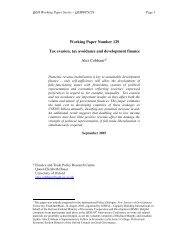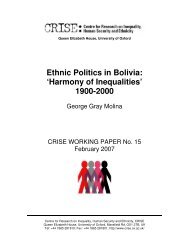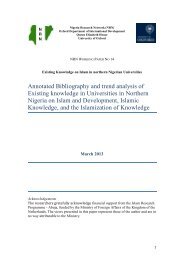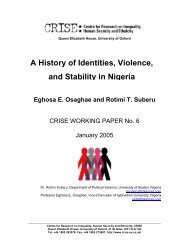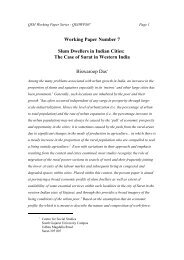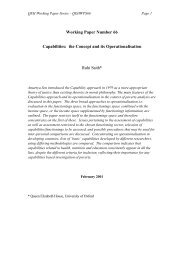Acute Multidimensional Poverty: A New Index for Developing ... - OPHI
Acute Multidimensional Poverty: A New Index for Developing ... - OPHI
Acute Multidimensional Poverty: A New Index for Developing ... - OPHI
You also want an ePaper? Increase the reach of your titles
YUMPU automatically turns print PDFs into web optimized ePapers that Google loves.
<strong>Acute</strong> <strong>Multidimensional</strong> <strong>Poverty</strong>: A <strong>New</strong> <strong>Index</strong> <strong>for</strong> <strong>Developing</strong> CountriesAlkire & Santos1. INTRODUCTIONIn June 2010, the UNDP released an assessment of What it would take to reach the MillenniumDevelopment Goals (MDGs hereafter) based on detailed studies in 50 countries. Its first key message isthat we need to address the deprivations that trap people in poverty together. Because they areinterconnected: “acceleration in one goal often speeds up progress in others…. Given thesesynergistic and multiplier effects, all the goals need to be given equal attention and achievedsimultaneously.” In doing so, the report echoed and strengthened an insight from the 2001 UNRoadmap towards the Implementation of the MDGs, which pointed out that “all the issues around povertyare interconnected and demand crosscutting solutions” (p 3). But how are the interconnections to beseen, and how can they in<strong>for</strong>m ‘crosscutting’ solutions?Amartya Sen, Nobel Laureate in Economics whose work underpins the concept and measures ofhuman development, has argued powerfully <strong>for</strong> the need to take a multidimensional approach topoverty as well as development: “Human lives are battered and diminished in all kinds of differentways, and the first task… is to acknowledge that deprivations of very different kinds have to beaccommodated within a general overarching framework” (Sen 2000). Sen’s perspective hasimplications <strong>for</strong> poverty measurement. “The need <strong>for</strong> a multidimensional view of poverty anddeprivation,” Anand and Sen wrote in 1997, “guides the search <strong>for</strong> an adequate indicator of humanpoverty.” 3In<strong>for</strong>med and inspired by previous work, 4 this paper implements a new international measure ofacute multidimensional poverty <strong>for</strong> 104 countries. What is distinctive about this multidimensionalpoverty index, or MPI, is that it reflects the overlapping deprivations that members of a householdexperience. By providing in<strong>for</strong>mation on the joint distribution of deprivations related to the MDGs– which shows the intensity and the composition of several aspects of poverty at the same time – wehave tried to explore how better measures could support ef<strong>for</strong>ts to accelerate the reduction ofmultidimensional poverty.Map of paper. The paper proceeds as follows. First, we set the context <strong>for</strong> the MPI by describingthe main differences between MPI and income poverty measures, and MDG indicators. Next, wedescribe the construction of the MPI, focusing on the normative selection of dimensions, indicators,cutoffs and weights; on the influence of data limitations; and on the methodology <strong>for</strong> identifyingwho is poor and aggregating data into a poverty index. We signal the main axiomatic properties ofthe MPI which make it particularly suited <strong>for</strong> the policy analysis that follows. Next, we introduce thedata sources used to calculate the MPI and the particular considerations and adaptations we havemade <strong>for</strong> each indicator. Following this, we present the main results of the MPI. First, we presentthe MPI findings and undertake key comparisons. Second, we drill down to explore more finely therelationship between MPI and income data. Third, we illustrate further features of the MPI that canin<strong>for</strong>m policy analysis: we decompose the MPI in greater detail <strong>for</strong> certain countries; we identifydistinct ‘types’ of poverty that begin to illustrate different regular patterns of deprivation, or povertytraps; and we explore changes in the MPI over time using time series data <strong>for</strong> three countries.Finally, we present a set of robustness tests <strong>for</strong> the MPI that focus on its robustness to changes inpoverty cutoffs, to changes in certain variables, and in the cross-dimensional cutoff k. We close by3 See also Sen 1992, Sen 1993, Foster and Sen 19974 In particular, the works cited above and also Bourguignon and Chakravarty (2003), Atkinson (2003), and Brandolini &D’Alessio (2009).www.ophi.org.uk July 2010 6



